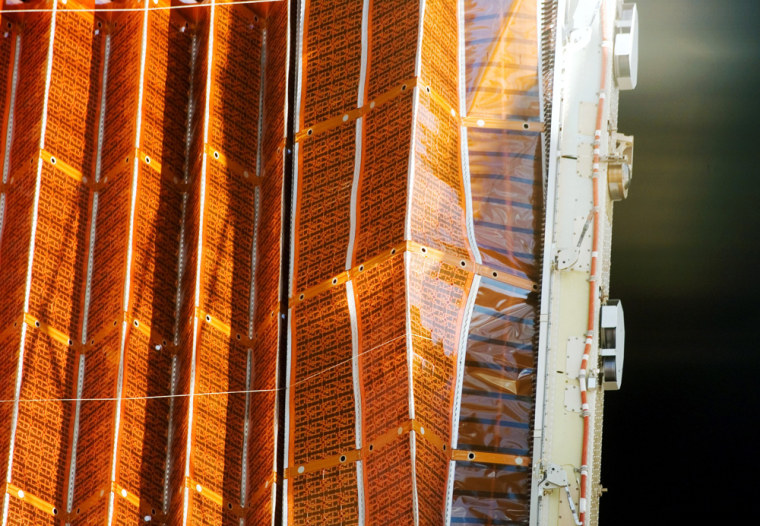After almost 50 start-and-stop commands, dozens of engineering huddles and seven hours of working on the task, NASA decided on Wednesday to leave a 115-foot (35-meter) solar wing on the international space station halfway retracted.
The space agency had wanted to retract it fully via remote control, but stubborn kinks and slackness in the guide wire did not resolve after several attempts.
Managers compared the challenge to folding up a used road map and stuffing it in the glove compartment. Experts from various disciplines — safety, spacewalking, engineering, to name a few — were meeting to decide what to do now.
The electricity-generating solar array served as a temporary power source aboard the orbiting outpost. NASA needed to move it out of the way so that a new, permanent pair of solar wings could rotate in the direction of the sun and generate power for the space station.
The wing was pulled back far enough, though, to allow that rotation to happen, and NASA began rotating the new solar wings shortly before 8 p.m. ET.
“We all tried as much up here as you guys did on the ground and it just wasn’t going to work for us today,” space station resident Michael Lopez-Alegria radioed to Houston. “But that stuff happens and I’m sure we’ll get through it.”
“Actually we consider it a success,” Mission Control astronaut Steve Robinson replied. “We’re looking at the SARJ rotating on the big screen up there and people are darn happy about it.”
“Yes, Steve,” Lopez-Alegria said, “the glass is definitely at least half full.”
The work was tedious and difficult, both for the flight controllers on the ground and the astronauts at the space station. They were repeatedly forced to unfold large sections of the golden wing they had just retracted in order to smooth out creases in the panels and counter slackness in the wire tension.
Because it had been six years since the wing was last folded up, flight controllers and astronauts were not sure how easy it would be.
“It’s kind of like folding a map up,” the space shuttle Discovery's commander, Mark Polansky, radioed Mission Control after the crease appeared. “You start folding it and the folding goes the wrong way. ... There’s nothing you can do to it other than pop it back in place or unfold it and try again.”
Slideshow 12 photos
Month in Space: January 2014
A “battalion” of people — including representatives from Lockheed Martin Corp., which made the array — are looking into how to fix the problem, said Kirk Shireman, deputy space station program manager. Astronauts could manually retract the array during a fourth spacewalk to be performed a day or two after the third scheduled spacewalk on Saturday, or even after Discovery returns to Earth. Or experts could come up with a new technique using the remote control to overcome the current hurdles.
Whether astronauts would, for example, poke the kinks with their gloved hands, or whether the station’s robotic arm would be deployed, are among the questions being explored. The Discovery crew has trained for some array contingency plans, and their 12-day mission has the flexibility to add on an extra day.
NASA managers expect to have a decision in the next couple of days. They note that the array, halfway retracted as it is now, is structurally sound and poses no safety concerns.
The next two spacewalks are scheduled to proceed as planned.
On Thursday and Saturday, astronauts will rewire connectors from the old solar array to the new solar wings. Reconfiguring the power system will enable the station to provide electricity to laboratories that will be added to the structure over the next few years.

